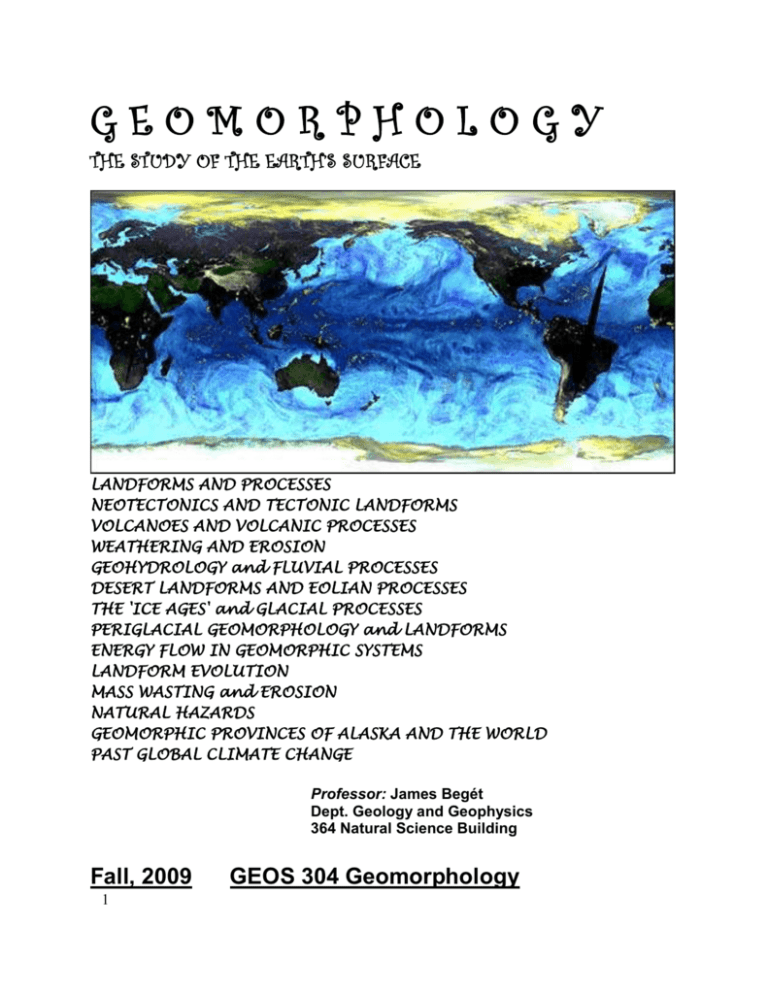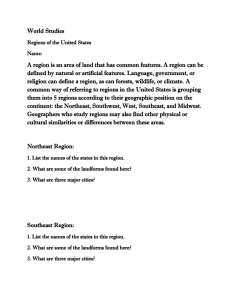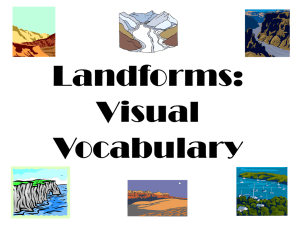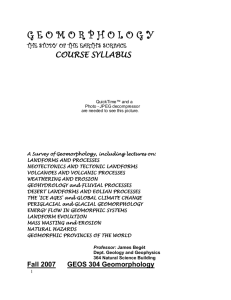GEOS 304 GEOMORPHOLOGY - University of Alaska Fairbanks
advertisement

GEOMORPHOLOGY THE STUDY OF THE EARTH’S SURFACE LANDFORMS AND PROCESSES NEOTECTONICS AND TECTONIC LANDFORMS VOLCANOES AND VOLCANIC PROCESSES WEATHERING AND EROSION GEOHYDROLOGY and FLUVIAL PROCESSES DESERT LANDFORMS AND EOLIAN PROCESSES THE 'ICE AGES' and GLACIAL PROCESSES PERIGLACIAL GEOMORPHOLOGY and LANDFORMS ENERGY FLOW IN GEOMORPHIC SYSTEMS LANDFORM EVOLUTION MASS WASTING and EROSION NATURAL HAZARDS GEOMORPHIC PROVINCES OF ALASKA AND THE WORLD PAST GLOBAL CLIMATE CHANGE Professor: James Begét Dept. Geology and Geophysics 364 Natural Science Building Fall, 2009 1 GEOS 304 Geomorphology °°°°°°°°°°°°°°°°°°°°°°°°°°°°°°°°°°°°°°°°°°°°°°°°°°°°°°°°°°°°°°°°°°°°°°°°°°°°°°°° COURSE SYLLABUS °°°°°°°°°°°°°°°°°°°°°°°°°°°°°°°°°°°°°°°°°°°°°°°°°°°°°°°°°°°°°°°°°°°°°°°°°°°°°°°° Course Information Course number: Credits: Place: Time: GEOS 304 3 235 NCSI Tu/Th 9:45-11:15 Instructor: Dr. James Begét (Jim) Office: Natural Science Building 364 Phone: 474-5301 Office Hours: Monday 9-12..(also by appointment) Textbook: Bloom, A. L. 2004. Geomorphology (3rd edition) Waveland Press, Illinois, USA Course Introduction: Geomorphology is the scientific study of the geologic history, processes, and features found at the surface of the earth. Geomorphology approaches these questions by determining the origin and characteristics of all of the earth’s landforms, including mountains, lakes, lava flows, fault scarps, beaches, terraces, moraines, etc. The origin of the various landscapes and features seen on the surface of the earth is of popular as well as scientific interest. The earliest known writings on natural science, in the 4th century BC by Aristotle and Herodotus, include observations of geomorphology and related natural phenomena. Leonardo da Vinci and others during the Renaissance tried to explain the origins of landforms, and Darwin, Humboldt, J. W. Powell, and others described new landforms from around the world as part of the scientific exploration of the earth during the 16-20th centuries. Today, a diverse suite of landforms has been described and catalogued from all parts of the earth's surface. However, the exploration and discovery of new landforms continues as it is an important part of the studies being done of surface geomorphic features on the planets and moons of our solar system. Modern geomorphology focuses on the types and rates of processes which create and modify landforms. These studies have “real-world” applications in evaluating climate and environmental change and natural hazards. This course will survey the landforms of the world, analyze the processes which operate in particular climates or tectonic settings to produce distinctive landforms, and discuss how geomorphology can be used to evaluate climate change and natural hazards in Alaska and other areas. Course Goals: 1) Recognition of the diversity and natural history of landscapes and landforms in Alaska and 2 throughout the world. (2) Introduction to modern methods of study of landforms, Quaternary sediments, and physical processes which modify the earth's surface. (3) Applications of geomorphology and surficial geology to natural hazards evaluations, engineering geology, land-use planning, economic geology, archeology, paleoecology, paleoclimatology, and other earth science problems. Course Format: Material will be presented in a lecture format. Each class will begin with an hour-long lecture, followed by slides/powerpoint images showing examples of landforms and illustrating the processes involved in their formation. Class discussion and participation are encouraged, and questions can be asked at any point in the lectures. Readings from the text supplement the lecture material and are required. Several "mini-labs" during the term will introduce students to geomorphologic data. A few films will be shown. A guest lecture or two is possible. Field Trips Geomorphology is a field science. There will be a required oneday field trip in late September, and we will use one class period to look at geomorphic features around the UAF campus. Neither trip is mandatory, but both are highly recommended. The in-class fieldtrip will also count as a “mini-lab.” Assigned Readings: Sections of the textbook are assigned each week in the syllabus. The readings are keyed to class lectures. You should try to read the text before the lecture. Exam questions will come from both the readings and lecture. Class Exercise (mini-labs): Several short exercises will be completed during the term. These "mini-labs" are designed to demonstrate fundamental concepts. You will need a pocket calculator for some exercises. Examinations: There will be three examinations, each covering one-third of the term. Each will account for 30% of the grade. Exams will cover lecture, readings, and in-class exercises. Exams will not be cumulative. No make-up exams will be given. If you know ahead of time that you must miss an exam, or if you miss an exam for an emergency (i.e. some natural hazard, of course) or other reason, please let me know as soon as possible and so we can arrange a replacement exam by appointment. Grading: Each of the three exams will count 30% of the final grade, so 90% of a student’s grade is based on the objective scores on the exams. The remaining 10 % is based on completion of 3 of the 4 in-class mini-labs and the class fieldtrip LECTURE OUTLINE AND ASSIGNED READING (REVISED) 3 PART ONE: CONSTRUCTIONAL PROCESSES Date SEPT. OCT. Lecture Topics Assigned Reading 3 Organisation Meeting, syllabus p. 1-8S; 3-12B 8 Syllabus Scope of Geomorphology History of Geomorphology Constructional processes 10 Neotectonic landforms, processes 15 continued 17 Tectonic geomorphology Constructional landforms, Faulting and folding 22 Paleoseismology, hazards 24 Neotectonics/ Alaskan seismic hazards 29 intro volcanic geomorphology p. 148-173S; 92-113B 1 Volcanic landforms, Volcanic processes 6 Mt. St. Helens./AK. volcanoes p. 8-27S; 19-34B p. 62-133S; 35-48B, 67-87B PART TWO: WEATHERING/SURFICIAL PROCESSES 13 Chemical weathering p. 189-203S; 117-146B 4 15 chemical weathering 20 Physical weathering Physical weathering (continued) 22 soils, karst p. 303-323S; 147-168B 27 mass wasting landslides, rockfalls p. 210-238S; 169-188B p. 204-209S NOV 29 Hillslope morphology progressive evolution p. 188-195B 3 Fluvial processes 5 Fluvial landforms 10 Paleohydrology, flood hazards p. 239-259S; 13-16B, 198-227B p. 260-280S; 231-274 12 PART THREE: SURFICIAL PROCESSES---CONTINUED 17 Shoreline processes p. 341-356S; 417-442B 19 Shoreline landforms p. 357-387S; 445-459B 24 Eolian-arid processes Eolian landforms DEC 1 Loess in Fairbanks/global climate change DEC 3 Periglacial processes Periglacial landforms 7 Geomorphology of glaciers ice sheetsvalley glaciers 10 Glacial Geology Glacier landforms p. 324-330S; 277-305B p. 331-340S p.388-397S; 309-322B p. 397-405S p. 417-429S p. 353-372B p. 430-467S; p. 373-390B p. 468-492S MERRY CHRISTMAS, HAPPY WINTER HOLIDAY, AND A HAPPY NEW YEAR!!! 5 6







